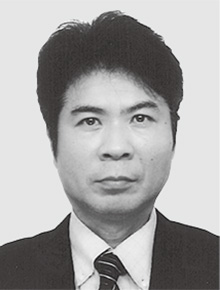Services, Systems, and Products for Smarter FactoriesIndustrial Controller for Integration of Advanced Control and Information Systems
Highlight
There are rising expectations in manufacturing for the new concept of generating added value by using digital technologies that include software and networks to make use of manufacturing site data. This is accelerating the implementation of industrial digital solutions for production optimization, production quality management, and equipment operation management that use digital technology for more advanced control of the machinery and equipment at manufacturing facilities and enable the sharing of data through seamless interconnection with information systems. Hitachi supplies industrial controllers for the Internet of Things that are needed to put this new concept into action and that are suitable for use at manufacturing sites. This article describes the core technologies for the integration of advanced control and information systems and presents examples of its use.
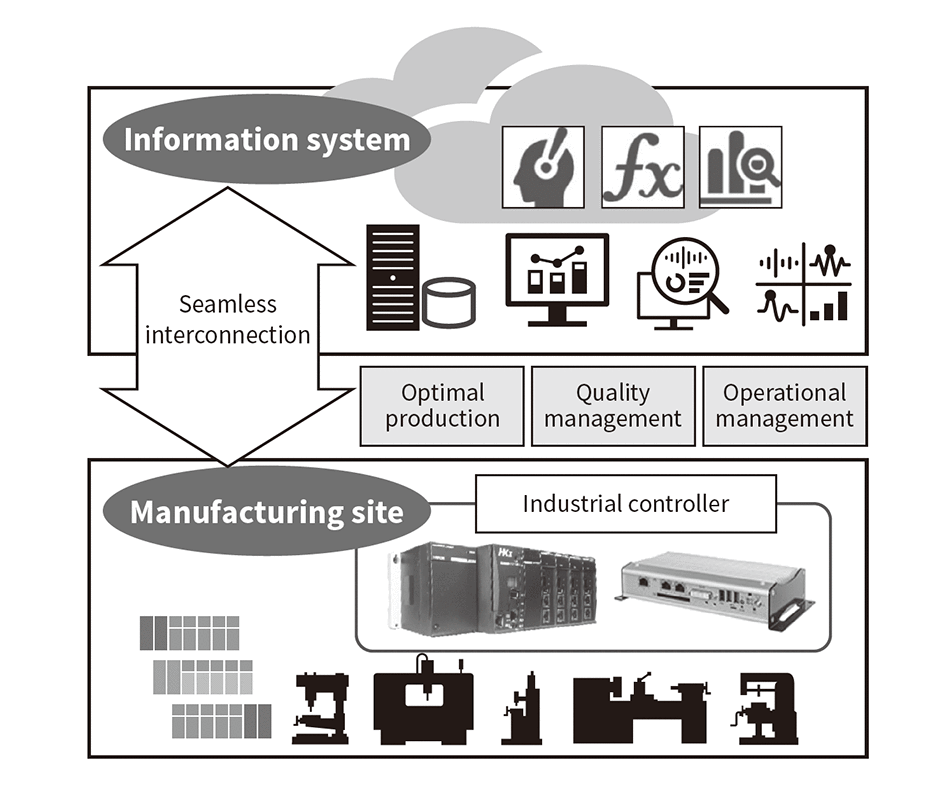
1. Introduction
Along with the increasing electrification of machinery and other equipment used in manufacturing sites, the performance of this machinery has been accelerated through the use of industrial controllers that feature more sophisticated forms of control.
Meanwhile, the use of digital solutions that is accompanying the digitization of manufacturing requires seamless interconnection between information systems and the machinery used in factories, and this in turn requires that the industrial controllers used to control this machinery and equipment be equipped with the necessary connectivity functions. This sophisticated control of machinery and equipment can be implemented using hardware and control networks that can operate at high speeds and controllers with real-time performance that can be used for motor drive. A problem arises, however, when devices such as industrial PCs are used to process data for interconnection with information systems because real-time performance is lost in the transfer of data between PC and controller, making seamless interconnection difficult.
This article presents a mix of use cases to describe the HX Series and HF-W/IoT Series of industrial controllers designed to work with the Internet of Things (IoT) (IoT-ready controllers) that provide seamless interconnection between information systems and the machinery used in factories without loss of real-time performance.
2. Real-time Control and Seamless Integration of Information
Fig. 1—Conceptual Diagram of Seamless Interconnection of Information System and Manufacturing Site Industrial controllers installed at a manufacturing site provide seamless interconnection between information systems and manufacturing site equipment.
Industrial controllers installed at a manufacturing site provide seamless interconnection between information systems and manufacturing site equipment.
Past practice for automation has been to use programmable logic controllers (PLCs) for real-time control of the systems and machines that make up a manufacturing site by means of hard-wired or network-connected sensors and actuators. Productivity improvement is an ongoing task at manufacturing sites with changes to PLC programs being made on a routine basis to improve equipment operation and performance. Moreover, the use of digitization to further optimize sites is accelerating, with PLCs collecting the actual data used in real-time control in the form of information that can then be analyzed together with other information from information systems (see Figure 1).
However, issues arise when embarking on new digitization initiatives in parallel with existing continuous improvement activities, including the risks associated with changes to existing PLC programs, connectivity with information systems, and the visibility of the data used. The same issues as with existing practices also arise when new equipment is installed. The risk associated with changes to existing PLC programs is that equipment will cease to operate due to the real-time execution of control being slowed by the addition of programs for data exchange in existing PLCs and information systems. Because control (the function of conventional PLCs) has been made to execute more quickly on the HX Series, it avoids the risks associated with the addition of programs for exchanging data with information systems. The other issues of connectivity with information systems and the visibility of the data used, meanwhile, have been resolved by implementing PLC functions as software, using information and communications technology, and being flexible in making program changes, thereby providing the features of a new IoT-ready controller that can interoperate with information systems. The HX Series of IoT-ready controllers also include an OT Hub Adaptor for site controllers that connects to the Hitachi Data Hub software for information systems. This provides bi-directional communications between information systems and the HX Series controllers installed at sites. This in turn gives access to manufacturing site data and enables optimization through feedback from information systems. This also contributes to the use of this connectivity to implement Lumada digital solutions.
Another product launched by Hitachi that provides a way to go about the further optimization of production facilities is the HF-W/IoT Series. This is an IoT-ready controller that incorporates a software PLC running on an HF-W Series industrial computer, a product that Hitachi has been supplying for 20 years. The HF-W/IoT Series can run Windows*1 applications concurrently with PLC functions and can be used to implement the digitization of manufacturing, including site data collection, the use of data through connections to information systems, and optimization of the manufacturing site by processing site data and using it for feedback.
- *1
- Windows is either a registered trademark or trademark of Microsoft Corporation in the United States and/or other countries.
3. Concepts behind Industrial Applications of the IoT and Their Core Technologies
Fig. 2—Comparison of Operation of Conventional PLC and HX Hybrid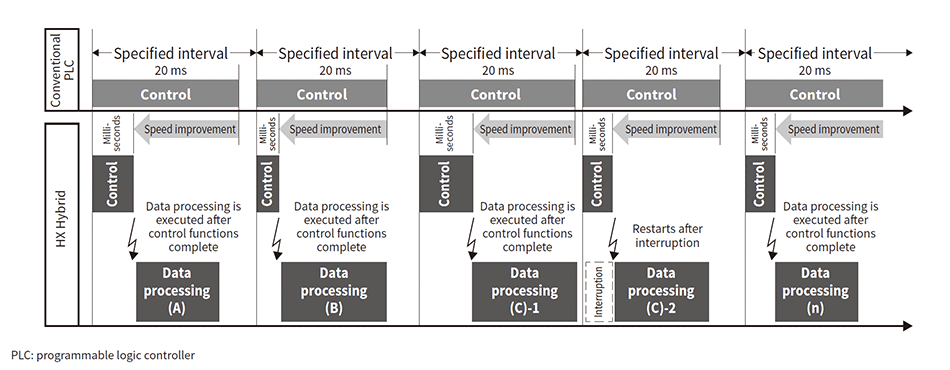 The HX Hybrid can execute data processing without affecting the cycle time for executing control thanks to an order of magnitude improvement in speed compared to a conventional PLC. With container technology being used to maintain real-time performance, data processing and real-time control run concurrently without the former interfering with the latter.
The HX Hybrid can execute data processing without affecting the cycle time for executing control thanks to an order of magnitude improvement in speed compared to a conventional PLC. With container technology being used to maintain real-time performance, data processing and real-time control run concurrently without the former interfering with the latter.
The HX Series of industrial controllers includes the HX Hybrid, a hybrid model that can handle both control and data processing. The model is highly regarded for its ability to interconnect with information systems without compromising real-time control performance.
For its PLC functions, the HX Hybrid supports programming methods that are being made into international standards (including IEC61131-3 and PLCopen*2), thereby enabling diverse forms of control while still maintaining real-time performance. With an execution speed that is more than 10 times faster than previous models, high-speed processing that is difficult to code using ladder logic can instead be programmed using other more suitable languages. This makes it possible to delegate tasks to the HX Hybrid that in the past would have been implemented on a PC or other computer (see Figure 2).
Container technology is used to keep control and data processing separate, executing control in real time without being affected by data processing. Programming languages suitable for interconnection with information systems (such as C/C++) can be used, and data can be shared between control and information functions without interfering with real-time control. This eliminates the need for the PC or other computer that would have been required in past systems.
By using real-time extensions for Windows to run a software PLC, the HF-W/IoT Series can execute real-time control of facility equipment concurrently with data processing functions on Windows, such as a human-machine interface (HMI) or data logging. The real-time performance of control is also maintained by using a multi-core central processing unit (CPU), with Windows and the software PC being allocated to separate CPU cores to prevent data processing from affecting control. Shared memory is provided for exchanging data between control and data processing functions and is used as a buffer to prevent any data loss in the transfer of regularly updated control data. Data synchronization is also maintained by a mechanism for handling data in blocks. Data definitions are stored in a file for easy updating.
- *2
- PLCopen is a registered trademark of PLCopen.
4. Technologies Used in IoT-ready Controller
Fig. 3—Technologies Used in HX Hybrid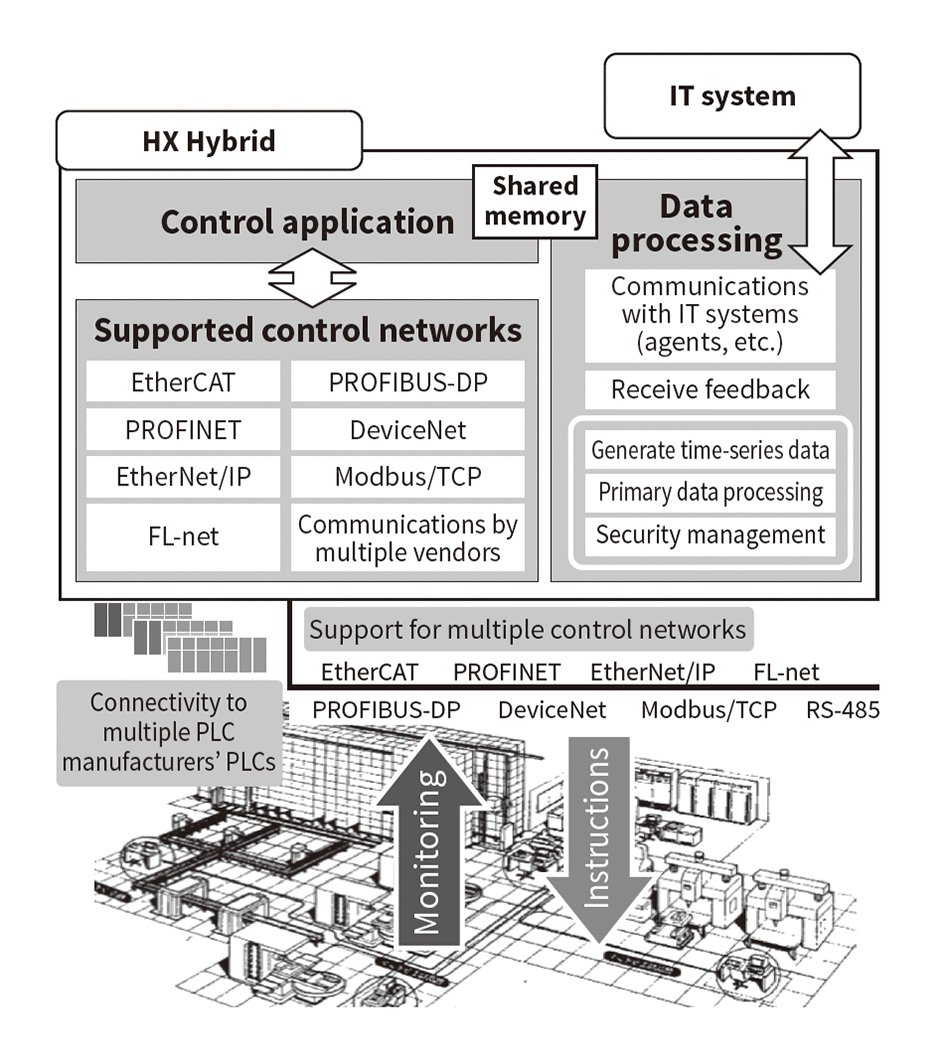 The HX Hybrid can run data programs and connect to PLCs from different companies as well as the various control networks used in manufacturing sites.
The HX Hybrid can run data programs and connect to PLCs from different companies as well as the various control networks used in manufacturing sites.
Fig. 4—Technologies Used in HF-W/IoT Series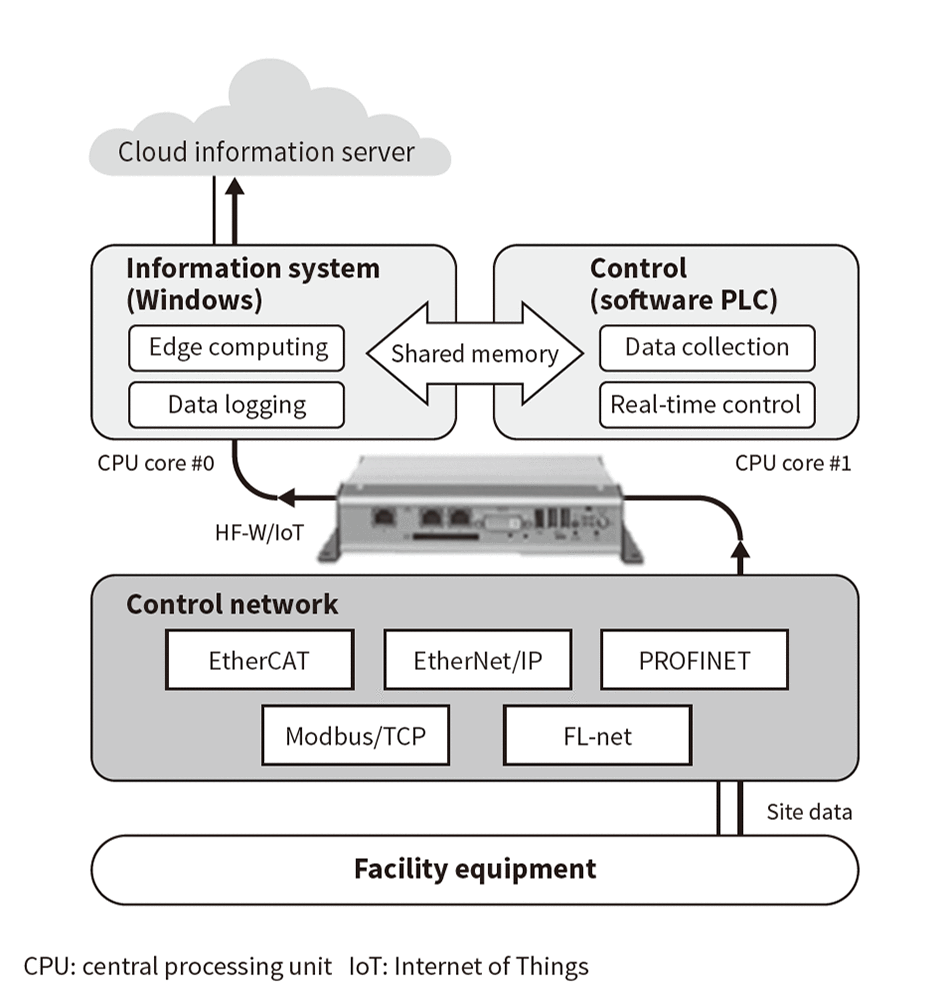 Data processing and control are executed on separate CPU cores with data exchange via shared memory and support for multiple control networks.
Data processing and control are executed on separate CPU cores with data exchange via shared memory and support for multiple control networks.
The smooth and flexible bidirectional exchange of data between information systems and manufacturing sites is essential to the implementation of digital solutions, and this task in the past was handled by a PC or gateway.
To achieve the seamless interconnection of information systems and the industrial controllers used in manufacturing sites without the use of such hardware, the controller must be able to satisfy the connection requirements of the information system. The problem has been, however, that the programs that run on the PLCs and other controllers used in these sites have traditionally been written using ladder logic (a programming language suited to automatic control), and this has not been compatible with the requirements of information systems. The difficulty in practice has been that attempting to use ladder logic to replicate data in the formats required by information systems, such as text or JavaScript Object Notation (JSON) interferes with the real-time performance required for control.
Key features of the HX Hybrid are that it provides faster execution of control and can use the C/C++ programming language to process information, meaning that it can satisfy the requirements of information systems while still maintaining real-time performance for control functions. It can also work with a variety of different control networks.
In addition to Ethernet-based control networks (including EtherCAT*3, EtherNet/IP*4, PROFINET*5, and FL-net), it also supports legacy standards that have long been used at manufacturing sites, such as Modbus*6, DeviceNet*7, and PROFIBUS*8. Programming support for communications with PLCs from other vendors is also being progressively added. It is possible to add the protocols needed for data processing, with one example application being the ongoing work on the use of manufacturing site data involving connection to Hitachi Data Hub (see Figure 3).
HF-W/IoT Series supports various forms of industrial Ethernet (PROFINET, EtherNet/IP, Modbus/TCP, and FL-net) and when combined with the shared memory described above, which can connect to existing control equipment and facility equipment, is able to collect data from this equipment concurrently with control execution, transfer it to information systems via shared memory, and forward it to servers in the cloud or elsewhere. This provides a seamless connection between the facility equipment and information servers (see Figure 4).
Hitachi has plans to add a database integration function to the HF-W/IoT Series. The function will store equipment data on a database on the HF-W/IoT in accordance with user-specified timings and events. This overcomes the problems of control and information systems having different response speeds and the large volume of real-time data collected at high frequency by only storing equipment data that requires a fast response, such as anomaly detection or feedback to control execution, and processing it on the HF-W/IoT.
- *3
- EtherCAT is a registered trademark and patented technology licensed from Beckhoff Automation GmbH of Germany.
- *4
- EtherNet/IP is a trademark of ODVA, Inc.
- *5
- PROFINET is a registered trademark of PROFIBUS Nutzerorganisation e.V. (PNO).
- *6
- Modbus is a registered trademark of Schneider Automation Inc.
- *7
- DeviceNet is a trademark of ODVA, Inc.
- *8
- PROFIBUS is a registered trademark of PROFIBUS Nutzerorganisation e.V. (PNO).
5. Use Cases
Fig. 5—Block Diagram of HX Hybrid System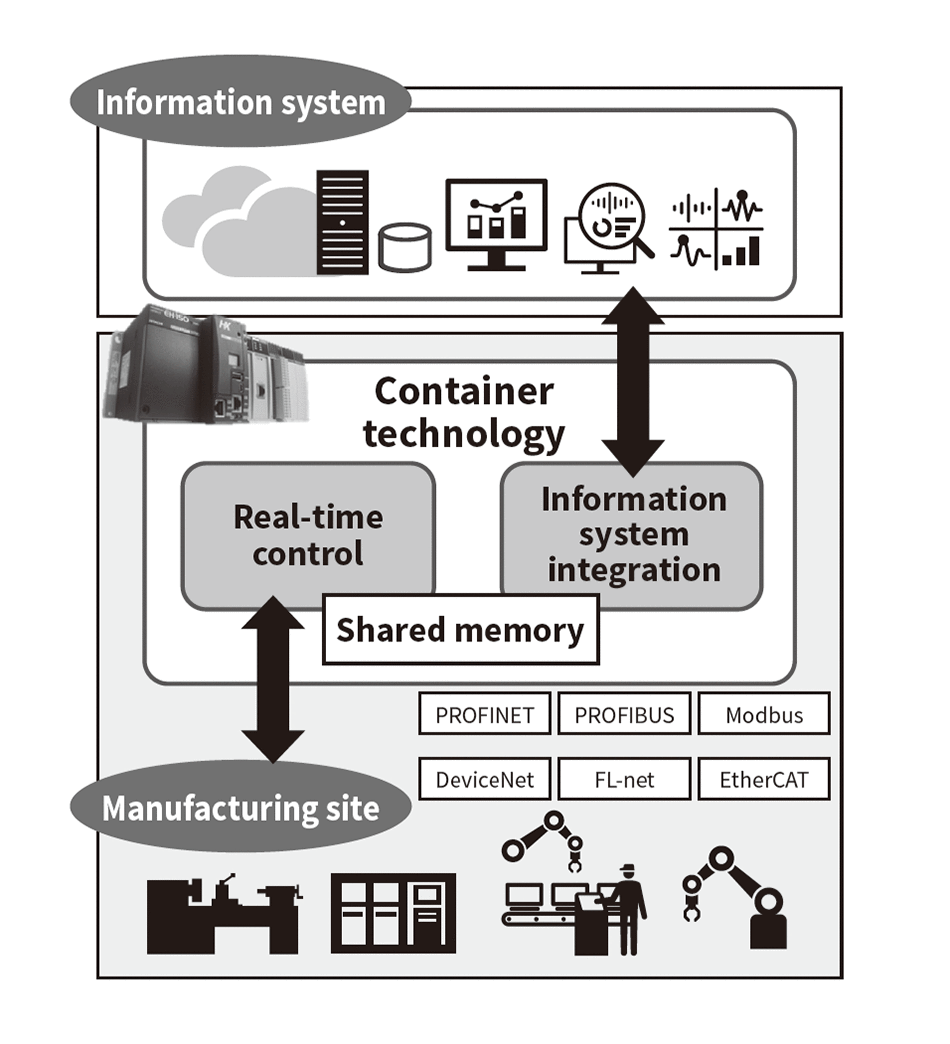 The HX Hybrid adds value to existing systems by performing control and information system integration.
The HX Hybrid adds value to existing systems by performing control and information system integration.
Fig. 6—Example of HF-W/IoT Used with Machine Tools or Semiconductor Manufacturing Equipment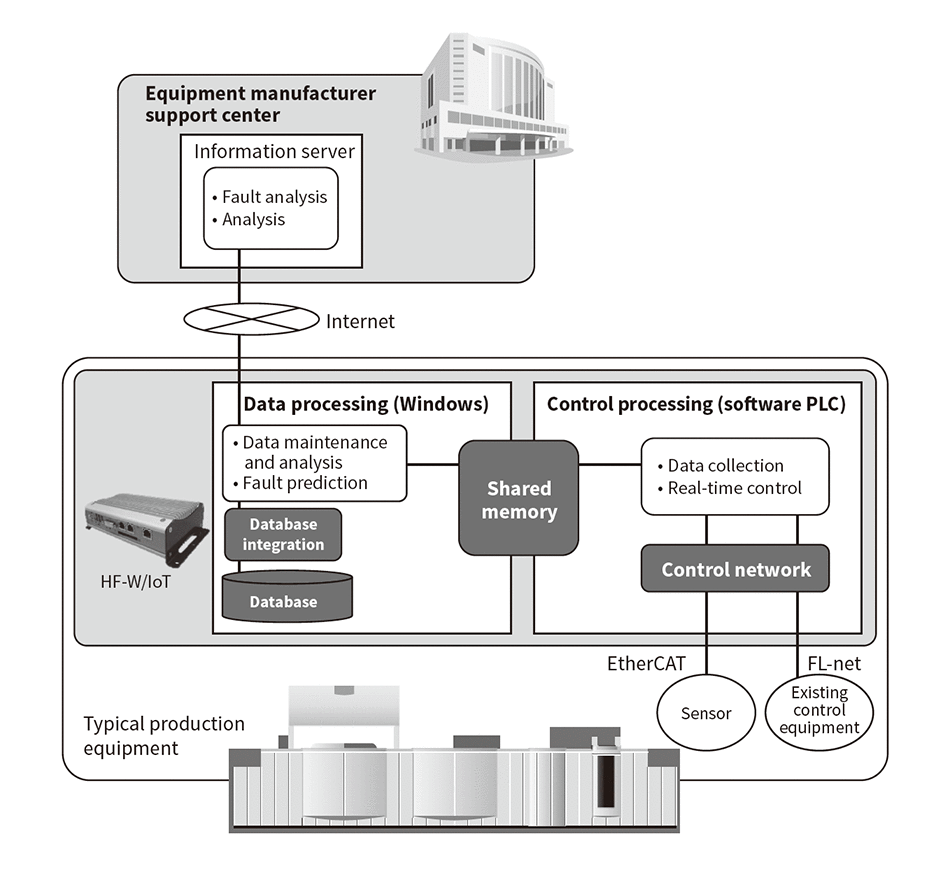 The HF-W/IoT makes production more efficient by collecting and analyzing operational data from control equipment and the sensors inside machinery and feeding the results back to control. It also enhances maintenance services by sending fault data to the support centers of equipment manufacturers.
The HF-W/IoT makes production more efficient by collecting and analyzing operational data from control equipment and the sensors inside machinery and feeding the results back to control. It also enhances maintenance services by sending fault data to the support centers of equipment manufacturers.
This section presents an example where the HX Hybrid IoT-ready controller was installed at a manufacturing facility and connected to machinery and other equipment to perform real-time control while also using shared memory to share data between the data processing container and control data, using the container’s information system interface to provide a seamless connection to information systems. The various applications running on the information systems were able to provide a wide variety of added value.
Figure 5 shows a block diagram of an HX Hybrid installed at a manufacturing site. The HX Hybrid delivers a lot of new added value by enabling the information systems to utilize data from existing systems connected via control networks and other means.
- More accurate production planning
The data needed to investigate production bottlenecks and potential improvements are collected along with acquisition of data on the operating conditions for existing equipment in real time and making it available via information and communications technology. - Reduced cost of upgrading aging systems
Upgrades to aging customer systems for the remote monitoring of a large amount of widely dispersed equipment can be undertaken in stages, with customer-specific communication protocols being implemented as needed to maintain compatibility. - Implementation of preventive maintenance and improvement of production quality
This involves storing the equipment operation parameters used for production together with product inspection and measurement data, looking for correlations between them, and then using this as feedback to the operation parameters. - Time savings on system integration
Marking and inspection systems record image data showing when marked inspection results are abnormal, making the tasks of determining what has happened and analyzing the causes more efficient. - Reduced cost of information system integration
Traceability can be provided for existing equipment by connecting to PLCs, collecting the required data from the equipment, and forwarding it to an information system.
Figure 6 shows a use case in which the HF-W/IoT is used with typical industrial equipment, such as machine tools or semiconductor manufacturing equipment. The equipment incorporates HF-W/IoT in the form of components that connect control and information as part of IoT implementation for this equipment. Sensor and other operational data is collected via EtherCAT and existing control equipment is connected via FL-net. The collected data are passed to the information systems via shared memory and stored in a database by the database integration function. By analyzing the collected operational data and providing feedback to control systems, data can be used for the maintenance operations of equipment manufacturers to improve production efficiency or by sending abnormal data to a support center, for example.
6. Conclusions
Fig. 7—Use of HX Hybrid to Enhance Edge Computing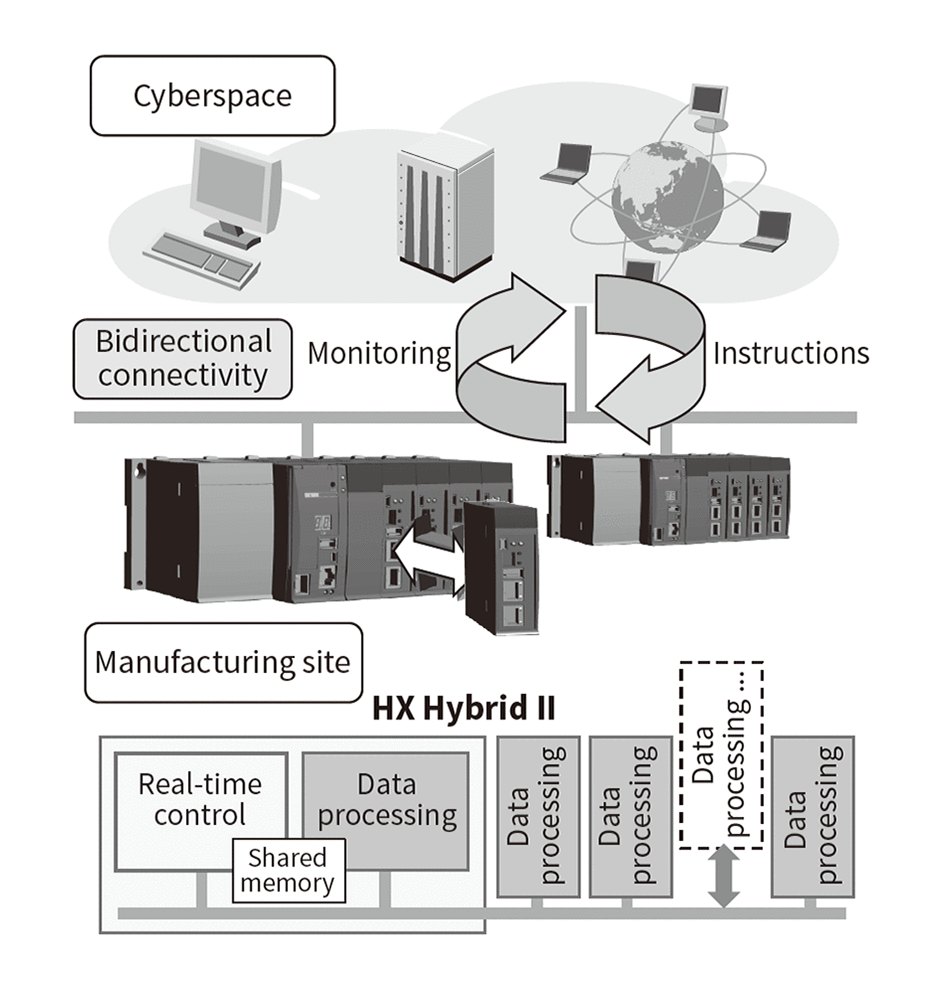 The diagram shows how HX Hybrid II and multiple CPU modules are used to implement edge computing in a scalable manner.
The diagram shows how HX Hybrid II and multiple CPU modules are used to implement edge computing in a scalable manner.
The HX Hybrid uses encapsulation to enable data processing to be added in a scalable manner, with hardware being provided that allows for use of multiple CPUs on site. It also provides for flexible integration through bidirectional connections between equipment and cyberspace. This is achieved by improving the flexibility of program development for processing information and by making it easy to add resources such as programming languages or software libraries, thereby enhancing edge computing functions that enable the on-site execution of the required data processing, including the preprocessing of data, artificial intelligence analytics, and protocol conversion (see Figure 7).
The HF-W/IoT Series has enhanced connectivity and the transfer of data from equipment to information systems by providing shared memory and support for a variety of different industrial networks in the form of components for interconnecting control and information systems. In the future, Hitachi intends to contribute to the adoption of the IoT in automation systems by linking control and information systems together through enhancements to edge computing functions for the on-site processing and analysis of collected data.
REFERENCES
- 1)
- Hitachi Industrial Equipment Systems Co., Ltd., “Programmable Logic Controllers,”
- 2)
- Hitachi Industrial Products, Ltd., “Industrial Computer ‘HF-W Series’
- 3)
- A. Ito et al., “IoT-compatible Equipment and Business Development for the Industrial Sector,” Hitachi Review, 66, pp. 536–544 (May 2017).
- 4)
- A. Ito et al., “IoT-ready Industrial Controller with Enhanced Data Processing Functions,” Hitachi Review, 67, pp. 206–211 (Mar. 2018).




